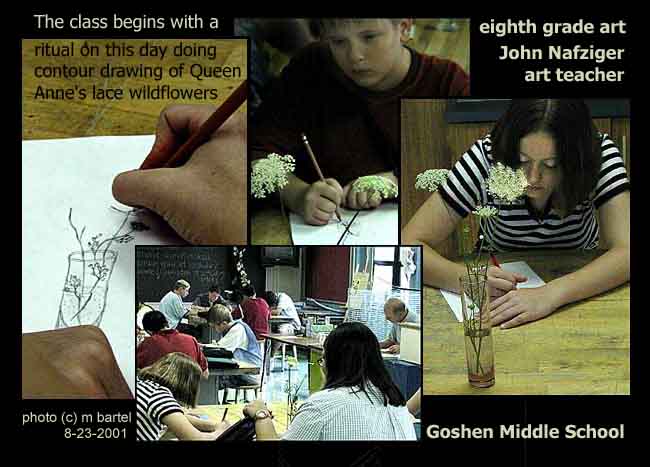|
Read
more about this
drawing
experience by
clicking
on the photo
|
|
|
P
ASS
I
T
O
N
Teach the Drawing Ritual to a Child or a Friend
Art 309, Art for Children,
Spring 2001
©
Marvin
Bartel, instructor
-
G
oal:
Get some early art teaching practice
by passing on observational drawing instruction to a child or a friend.
This assignment is intended to help you make the transition form being
a professional student to being a professional teacher. As students we
learn for a test or we learn a skill so we can do something better.
As teachers we are learning things so we can teach them. When we teach
them we find that we actually learn them ourselves much better than we
ever learned as students.
-
P
reparation:
Don't begin this until you have
studied
Drawing on the Right Side of the Brain
by Betty Edwards
(especially chapters 2 and 3) and read the essay on
Rituals
in the Art Classroom
. You might get some good ideas by reading the
instructions for
preparing
art lessons
. This assignment doesn't require all the parts in, "
Planning
to Teach Art Lessons
", but those instructions have several ideas about
teaching art and motivation that you can use while you are teaching these
drawing lessons.
-
W
hen:
Start on this by February 5th or sooner
if you can. Finish before mid-March. Start now to look for somebody willing
to be your student.
-
W
ho to Teach?
Get a friend, roommate, spouse,
relative, or child in third grade or older (somebody who has not
studied art in college and somebody not in this class). Find a person who
is willing to draw for 5 to 10 minutes at least 6 times over a period of
10 to 20 days.
-
W
hat to teach?
Explain to them how to do blind
contour drawings. Use a pencil blinder. Use a viewfinder. Optionally, add
observed shade and shadow. Use ball point and pencil and plain paper.
-
W
hat to have them draw?
- Select things to draw that interest your student.
- Select subjects for which your student would NOT have a previously
learned schema. They are more apt to look at it carefully instead of feeling
they can draw it from memory.
- Hobby and sports gear are good. Bent cans are good. Toys are good.
Food is good. Trees are good. Mirrors are good. It must be observable in
a slow deliberate "edge finding" contour mode.
-
H
ow to instruct?
Be sure they are slow,
careful, and deliberate using continuous line,
not
sketchy lines.
Be sure they understand that they carefully examine and follow the contour
of the observed object(s), only looking at the paper when the drawing tool
has to find a new place to start. Do NOT show them your work. Do
NOT demonstrate to them how you do it. Do run your finger very slowly along
the edge of the thing the student is drawing. Do encourage slow, concentrated
looking.
-
W
hat to do with the drawings?
They should be
dated, titled, and the experiences should be described by you in your journal.
Analyze the teaching experiences as well. Give the age of the student and
include the phone number and name of your student or the parents of the
child. Bind them in your sketchbook/journal so they are a complete series
of work by one person (your student) if possible. After this semester is
over, you may return the drawings to the student or parents if they want
them.
-
J
ournal?
When you journal the
teaching experience, include your own reflections about the teaching and
learning process. It can start with description and summary of what you
did, but also say what you learned and how it felt to be a teacher. Say
what aspects you felt positive about and what parts you wish could have
gone better. Mention any unexpected responses from your student and say
what you did and what you might do another time if you have a chance.
-
A
ssessment?
The instructor will study the drawings,
the subjects selected, your descriptions and self-evaluations. The student
or parents may be called for their response to your teaching. This may
provide a basis on which to help you become a better drawing teacher.

Click
on the image to read more about classroom rituals
This page © Marvin
Bartel, instructor - updated 1-9-2002
Art for Children
class members may print this for their own use. Others must e-mail marvinpb@goshen.edu
for permission to reproduce or publish.
Back to:
Art for Children
Calendar
Art for Children
Assignments
Page
Art For Children
Home page
Art for Children
Syllabus
Marvin Bartel
Home
Marvin Bartel
Courses
Goshen College
Art
Gallery

|


